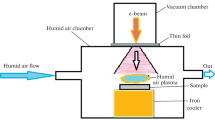Abstract
We present the results of measurements of the air ion densities of both signs in the unventilated underground laboratory of the Moscow State University. We used the stationary station based on a Sapfir-3M modified air ion counter. We solved the problems of accuracy of relative measurements of air ion densities and stability of measurements in conditions of high humidity of underground cavities. We investigated the spatial distribution of air ion densities and their variability over time. An excess of positively charged air ions was found everywhere in the laboratory. The obtained data indicate the presence of a weak electric field directed downward in the underground laboratory. We observed the dependence of the air ion densities of both signs on the atmospheric pressure. We found the correlation of air ion densities with radon activity in the laboratory air and show that the ionization of air by alpha particles from the decay of radon and its daughter elements is the main source of air ions in closed underground cavities. A variant for explaining the presence of an excess of positive charge in underground cavities is proposed.








Similar content being viewed by others
REFERENCES
Averin, V.G., Aronzon, B.A., Babaev, N.S., et al., Tablitsy fizicheskikh velichin. Spravochnik (Tables of Physical Quantities: A Handbook), Kikoin, I.K., Ed., Moscow: Atomizdat, 1976.
Bezrukov, L.B., Zavarzina, V.P., Kurlovich, A.S., et al., On the negatively charged layer of the Earth’s electric field, Dokl. Phys., 2018, vol. 480, no. 2, pp. 177–179. https://doi.org/10.1134/S1028335818050051
Bezrukov, L.B., Zavarzina, V.P., Karpikov, I.S., et al., Interpretation of measurement results of the potential difference in Lake Baikal, Geomagn. Aeron. (Engl. Transl.), 2019, vol. 59, no. 5, pp. 623–627. https://doi.org/10.1134/S0016793219040054
GOST R 8.844-2013. Schetchiki legkikh ionov. Aspiratsionye. Metodika poverki (GOST R 8.844-2013. Aspiration Light Air Ion Counters. Verification Procedure), Moscow: Standartinform, 2015.
Korotaev, S.M., Shneyer, V.S., Gaidash, S.P., et al., The effect and precursors of the earthquake of August 28, 2008, in the vertical component of the electric field in Lake Baikal, Dokl. Earth Sci., 2011, vol. 438, no. 5, pp. 842–845.
Korotaev, S.M., Budnev, N.M., Serdyuk, V.O., et al., Recent results of monitoring of the vertical component of the electrical field in Lake Baikal on the surface-bed baseline, Geomagn. Aeron. (Engl. Transl.), 2015, vol. 55, no. 3, pp. 398–409.
Mikiver, A., Measurements of air ion concentrations and electric field strengths for HVDC applications, Master’s Thesis in Electric Power Engineering, Gothenburg, Sweden: Chalmers University of Technology, Department of Materials and Manufacturing Technology, 2017. https://publications.lib.chalmers.se/records/fulltext/ 251332/251332.pdf.
Schiessling, J., Mikiver, A., and Serdyuk, Y.V., Dynamics of ion concentration in air affected by Applied DC electric field and humidity, in 2018 IEEE Conference on Electrical Insulation and Dielectric Phenomena (CEIDP), Cancun, Mexico, 2018, pp. 207‒210. https://doi.org/10.1109/CEIDP.2018.8544836.
Viggiano, A.A. and Arnold, F., Ion chemistry and composition of the atmosphere, in Handbook of Atmospheric Electrodynamics, Volland, H., Ed., Boca Raton, Fla.: CRC Press, 1950, pp. 1–26. https://doi.org/10.1201/9780203719503.
Warden, S., Bleier, T., and Kappler, K., Long term air ion monitoring in search of pre-earthquake signals, J. Atmos. Sol.-Terr. Phys., 2019, vol. 186, pp. 47–60. https://doi.org/10.1016/j.jastp.2019.01.009
ACKNOWLEDGMENTS
The authors thank Academician I.I. Tkachev for fruitful discussions and support, as well as V.B. Semikoz for the opportunity to speak at a seminar in IZMIRAN (Moscow) on the topic of this article and for participating in the discussion at this seminar. L.A. Kuzmichev provided a great help by providing an opportunity to carry out measurements in the underground laboratory of the Moscow State University Scientific Institute of Nuclear Physics. The authors express their gratitude to Timo Enqvist (Finland) for the opportunity to make measurements in the Pyhӓsalmi copper mine.
Author information
Authors and Affiliations
Corresponding authors
Ethics declarations
The authors declare that they have no conflicts of interest.
Rights and permissions
About this article
Cite this article
Bezrukov, L.B., Gromtseva, A.F., Zavarzina, V.P. et al. Observation of an Excess of Positive Air Ions in Underground Cavities. Geomagn. Aeron. 62, 743–755 (2022). https://doi.org/10.1134/S0016793222060020
Received:
Revised:
Accepted:
Published:
Issue Date:
DOI: https://doi.org/10.1134/S0016793222060020




